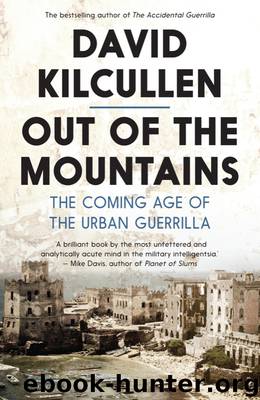Out of the Mountains by David Kilcullen

Author:David Kilcullen
Language: eng
Format: epub
Tags: HIS027000, HIS027060
Publisher: Scribe Publications
Published: 2013-09-25T04:00:00+00:00
Conclusions: Urban Competitive Control
As I mentioned at the start of this chapter, techniques that we might label as “fishing traps,” which attract populations and then lock them into a network of incentives to prevent them from escaping, are common to insurgencies, criminal organizations, mass movements, and other state and nonstate groups, as well as governments. In the context of violent conflict, however, the most relevant subset of these techniques is the group of methods I’ve described, using the theory of normative systems, as competitive control. These systems of competitive control apply a range of capabilities across a spectrum from persuasion through administration to coercion, and they are designed by armed actors—owners or proponents of the system—as a means to corral, control, manipulate, and mobilize populations. As we’ve seen, a wide-spectrum system of control tends to outcompete a narrow-spectrum one, because its proponent can always bounce back from a defeat in one part of the spectrum by compensating with capabilities from another.
The initial examples we examined were from relatively simple rural settings in Afghanistan. Exactly the same types of behaviors and patterns of interaction are evident in the urban examples we looked at in previous chapters, and in the urban Iraqi examples discussed in this chapter. As we’ve also just noted, the interaction between armed groups and populations is not a one-way process: populations employ many strategies to manipulate and manage armed actors, seeking to minimize risk, maximize predictability, and limit encroachments upon their autonomy. Again, this pattern of behavior isn’t unique to insurgencies but is applicable to all forms of nonstate armed group that seek to control a population, and (in a functional sense) to states as well. It is thus potentially a useful explanatory tool as we examine the interplay between populations, nonstate armed groups, and governments in the marginalized urban and periurban environments that are becoming increasingly common across the planet.
Where urban environments of the future will differ from these examples, however, is in the vastly increased local and transnational connectivity they can access, and thus in the ability of nonstate armed groups or state sponsors in marginalized areas in one part of the world to manipulate and mobilize populations on the other side of the globe, and vice versa. The next chapter looks at the broader connectivity and networking issue, and seeks to locate this theoretical discussion in some practical observations of current conflict in connected cities.
Download
This site does not store any files on its server. We only index and link to content provided by other sites. Please contact the content providers to delete copyright contents if any and email us, we'll remove relevant links or contents immediately.
| Automotive | Engineering |
| Transportation |
Whiskies Galore by Ian Buxton(41509)
Introduction to Aircraft Design (Cambridge Aerospace Series) by John P. Fielding(32876)
Small Unmanned Fixed-wing Aircraft Design by Andrew J. Keane Andras Sobester James P. Scanlan & András Sóbester & James P. Scanlan(32558)
Craft Beer for the Homebrewer by Michael Agnew(17917)
Turbulence by E. J. Noyes(7682)
The Complete Stick Figure Physics Tutorials by Allen Sarah(7119)
Kaplan MCAT General Chemistry Review by Kaplan(6567)
The Thirst by Nesbo Jo(6421)
Bad Blood by John Carreyrou(6260)
Modelling of Convective Heat and Mass Transfer in Rotating Flows by Igor V. Shevchuk(6216)
Learning SQL by Alan Beaulieu(6012)
Weapons of Math Destruction by Cathy O'Neil(5805)
Man-made Catastrophes and Risk Information Concealment by Dmitry Chernov & Didier Sornette(5626)
Digital Minimalism by Cal Newport;(5354)
Life 3.0: Being Human in the Age of Artificial Intelligence by Tegmark Max(5165)
iGen by Jean M. Twenge(5143)
Secrets of Antigravity Propulsion: Tesla, UFOs, and Classified Aerospace Technology by Ph.D. Paul A. Laviolette(4903)
Design of Trajectory Optimization Approach for Space Maneuver Vehicle Skip Entry Problems by Runqi Chai & Al Savvaris & Antonios Tsourdos & Senchun Chai(4832)
Electronic Devices & Circuits by Jacob Millman & Christos C. Halkias(4728)
